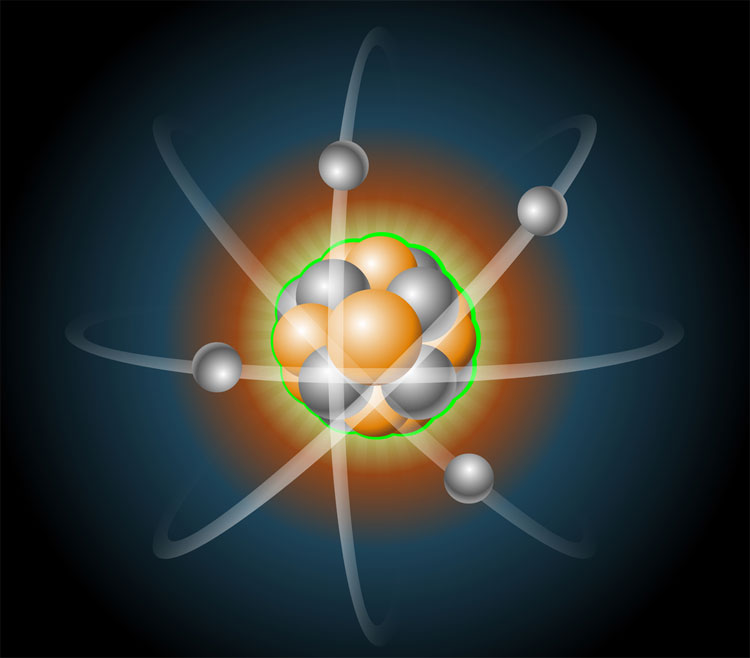Mysteriously Shrinking Proton Continues to Puzzle Physicists

DENVER — The size of a proton, long thought to be well-understood, may remain a mystery for a while longer, according to physicists.
Speaking today (April 13) at the April meeting of the American Physical Society, researchers said they need more data to understand why new measurements of proton size don't match old ones.
"The discrepancy is rather severe," said Randolf Pohl, a scientist at the Max Planck Institute of Quantum Optics. The question, Pohl and his colleagues said, is whether the explanation is a boring one — someone messed up the measurements — or something that will generate new physics theories. [Wacky Physics: The Coolest Particles in Nature]
The incredible shrinking proton
The proton is a positively charged particle in the nucleus of atoms, the building blocks of everything. Years of measurements pegged the proton at 0.8768 femtometers in radius (a femtometer is a millionth of a billionth of a meter).
But a new method used in 2009 found a different measurement: 0.84087 femtometers, a 4 percent difference in radius.
The previous measurements had used electrons, negatively charged particles that circle the nucleus in a cloud, to determine proton radius. To make the measurement with electrons, researchers can do one of two things. First, they can fire electrons at protons to measure how the electrons are deflected. This electron-scattering method provides insight into the size of the positively charged proton.
Get the world’s most fascinating discoveries delivered straight to your inbox.
An alternative is to try to make the electron move. Electrons zing around the nucleus of an atom, where protons reside, at different levels called orbitals. They can jump from orbital to orbital by increasing or decreasing their energy, which electrons do by losing or gaining an elementary particle of light called a photon. The amount of energy it takes to budge an electron from orbital to orbital tells physicists how much pull the proton has, and thus the proton's size.
Pohl and his colleagues didn't use electrons at all in their measurements of the proton. Instead, they turned to another negatively charged particle called the muon. The muon is 200 times heavier than an electron, so it orbits the proton 200 times closer. This heft makes it easier for scientists to predict which orbital a muon resides in and thus a much more sensitive measure of proton size.
"The muon is closer to the proton and it has a better view," Pohl said.
Possible explanations
These sensitive muon measurements are the ones that gave the smaller-than-expected result for the proton radius, a totally unexpected discovery, Pohl said. Now, physicists are racing to explain the discrepancies.
One possibility is that the measurements are simply wrong. Pohl said this "boring explanation" is the most probable, but not all physicists agree.
"I would say it's not the experimental side," said Massachusetts Institute of Technology physicist Jan Bernauer.
The electron-based measurements have been repeated many times and are well-understood, Bernauer said, and muon experiments have the advantage that if they're done wrong, they don't provide results at all.
If experimental error turns out not to be the culprit, there may be some calculation issue, "so we actually know everything that goes on but we are just not calculating it quite right," Bernauer told reporters.
Most exciting of all, the discrepancy could reveal some new physics not explained by the dominant physics theory, the Standard Model. Perhaps there is something unknown about how muons and electrons interact with other particles, said John Arrington, a physicist at Argonne National Laboratory in Illinois. [Twisted Physcis: 7 Mind-Blowing Findings]
One possibility is that photons aren't the only particles that carry forces between particles — perhaps an unknown particle is in the mix, causing the proton-measurement discrepancies.
Next steps
To find out what's going on, physicists are launching a new set of experiments across multiple laboratories. One major line of research involves testing electron-scattering experiments to be sure they've been done correctly and that all the facets are understood, Arrington said.
Another goal is to repeat the scattering experiments, but instead of shooting electrons at protons they'll shoot muons at protons. This project, the Muon Scattering Experiment, or MUSE, is set to take place at the Paul Scherrer Institute in Switzerland. The facilities there will allow researchers to simultaneously measure electron- and muon-scattering in one experiment.
"The hope is that on the electron-scattering side, we'll have double-checked all the things that are challenging in these measurements," Arrington said. "If we still have this discrepancy, we'll be able to fill in this last box and look at the muon-scattering and see, independent of how you make the measurement, do electrons and muons give you something different?"
The plan is to start collecting data in that experiment in 2015 or 2016, Arrington said, meaning the size of the proton will remain in limbo for a little longer.
"It's not easy," Arrington said. "We hope to do it in a little less than 10 years, but maybe we're being optimistic."
Follow Stephanie Pappas on Twitter and Google+. Follow us @livescience, Facebook & Google+. Original article on LiveScience.com.

Stephanie Pappas is a contributing writer for Live Science, covering topics ranging from geoscience to archaeology to the human brain and behavior. She was previously a senior writer for Live Science but is now a freelancer based in Denver, Colorado, and regularly contributes to Scientific American and The Monitor, the monthly magazine of the American Psychological Association. Stephanie received a bachelor's degree in psychology from the University of South Carolina and a graduate certificate in science communication from the University of California, Santa Cruz.


